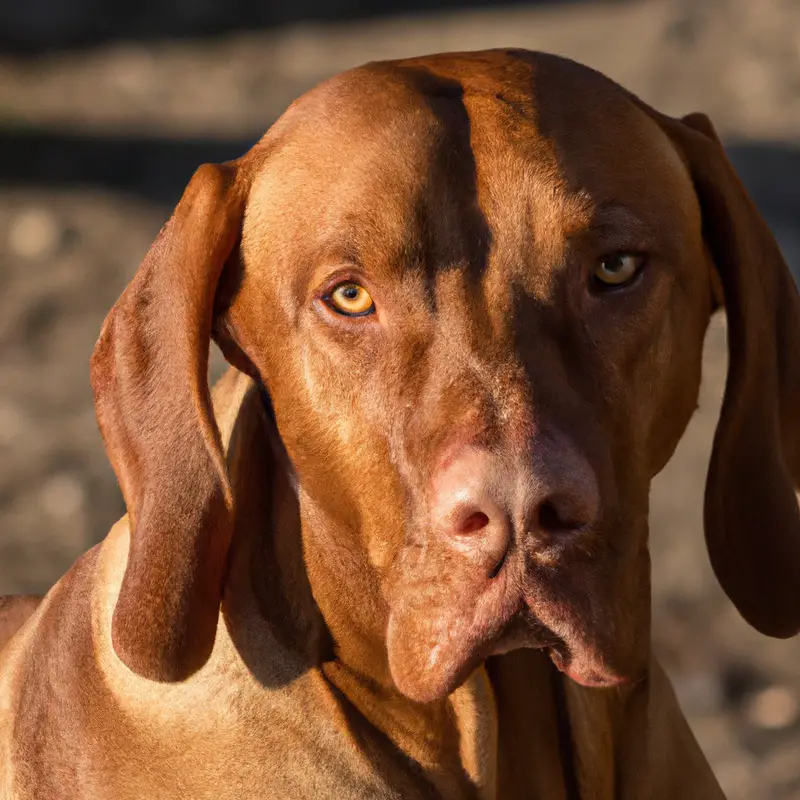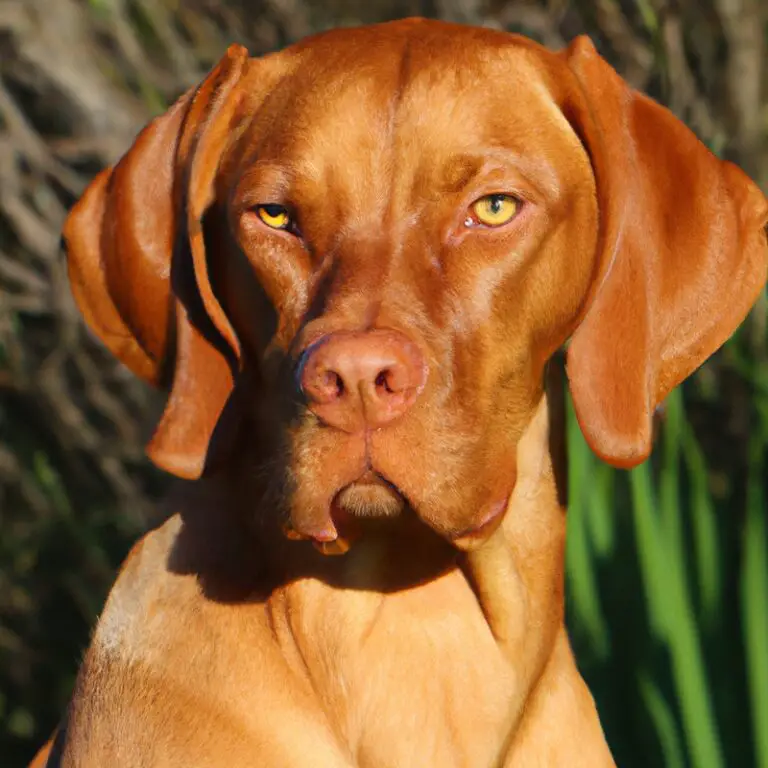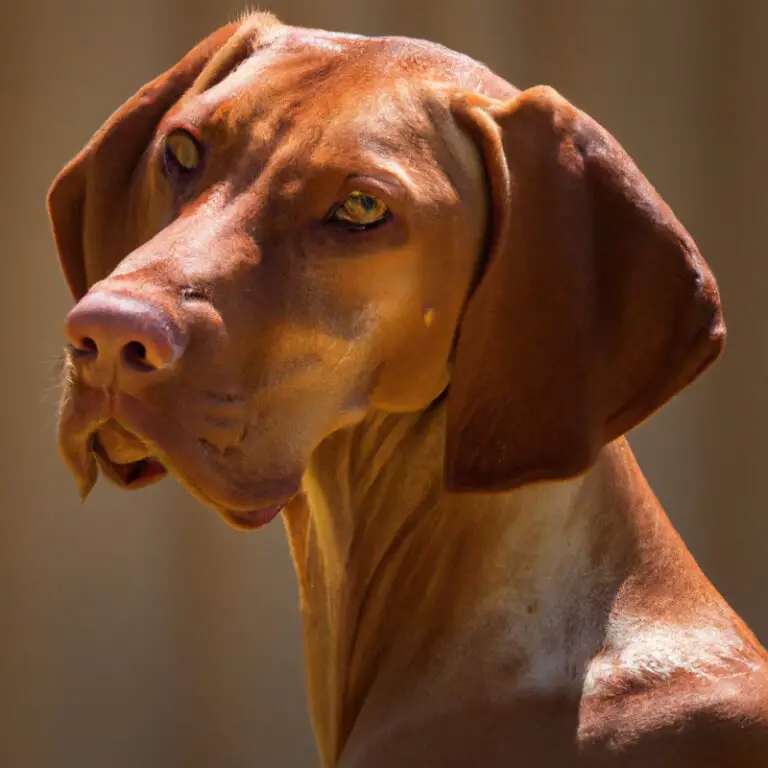What Are The Signs Of a Healthy Vizsla?
Key Takeaways:
- Body condition: You should be able to feel, but not see, your Vizsla’s ribs. A healthy Vizsla should have a trim waistline.
- Coat and skin: A shiny and lustrous coat, without any bald patches or skin irritations, indicates a healthy Vizsla.
- Energy and activity level: A lively and energetic Vizsla who enjoys physical activity is a good sign of overall health.
- Appetite and digestion: A healthy Vizsla should have a good appetite and regular, firm bowel movements.
Imagine having a furry companion who is not only incredibly lovable, but also the epitome of good health. That’s what every Vizsla owner dreams of, and today, I’m here to share with you the signs that indicate a healthy Vizsla.
From a shiny coat to bright eyes, strong teeth to an energetic body, there are several physical indicators to keep an eye out for.
But it doesn’t stop there! A healthy Vizsla also exhibits happy behavior, alertness, and excellent social skills. Of course, it’s important to be aware of potential health issues and to know how to maintain your Vizsla’s well-being.
So, let’s dive in and discover the secrets to a thriving and vibrant Vizsla!
| Signs of a Healthy Vizsla | Description |
| 1. Bright Eyes | Vibrant and clear eyes without discharge or redness |
| 2. Shiny Coat | Soft and glossy coat, free from dandruff and skin issues |
| 3. Optimal Weight | Maintains a healthy weight; not underweight or overweight |
| 4. Good Muscle Tone | Well-defined muscles without excessive fat or thinness |
| 5. Energetic | Displays high activity levels and enthusiasm |
| 6. Appetite | Has a healthy and consistent appetite |
| 7. Good Hydration | Properly hydrated with clear urine |
| 8. Regular Bowel Movements | Normal and regular bowel movements without diarrhea or constipation |
| 9. Clear Breathing | Breathes comfortably and without coughing or wheezing |
| 10. Healthy Teeth and Gums | Clean teeth and gums, free of plaque and bad breath |
Physical signs of a healthy Vizsla
Shiny coat and healthy skin
A shiny coat and healthy skin are signs of a healthy Vizsla. Here’s what you should look for:
- Shiny Coat: A healthy Vizsla has a glossy coat that reflects light. The fur should be smooth and free of tangles or mats. Regular brushing helps maintain their coat’s shine.
- Healthy Skin: Check for any redness, itchiness, or flakiness on your Vizsla’s skin. Healthy skin should be pink and free of sores or irritations. A balanced diet with omega-3 fatty acids can promote skin health.
Remember, regular grooming and a nutritious diet are key to maintaining a Vizsla’s shiny coat and healthy skin.
Clear and bright eyes
Clear and bright eyes are a clear indication of a healthy Vizsla. They should be free from any discharge or redness.
The whites should be clear and not yellowish.
The pupil should appear dark and the iris should have a vibrant color. If you notice any cloudiness or changes in your Vizsla’s eyes, it’s important to consult with a veterinarian for a proper evaluation.
Regular eye check-ups are essential to maintain your dog’s ocular health.

Good weight and muscle tone
A healthy weight and well-developed muscle tone are important signs of a healthy Vizsla. It shows that your Vizsla is in good physical shape and overall health.
Keeping your Vizsla at an appropriate weight is crucial to prevent obesity-related health issues.
Regular exercise and a balanced diet are key to maintaining good muscle tone and weight. Providing a combination of physical activity, such as walking, running, and playing, along with a nutritious diet, will help your Vizsla stay fit and strong.
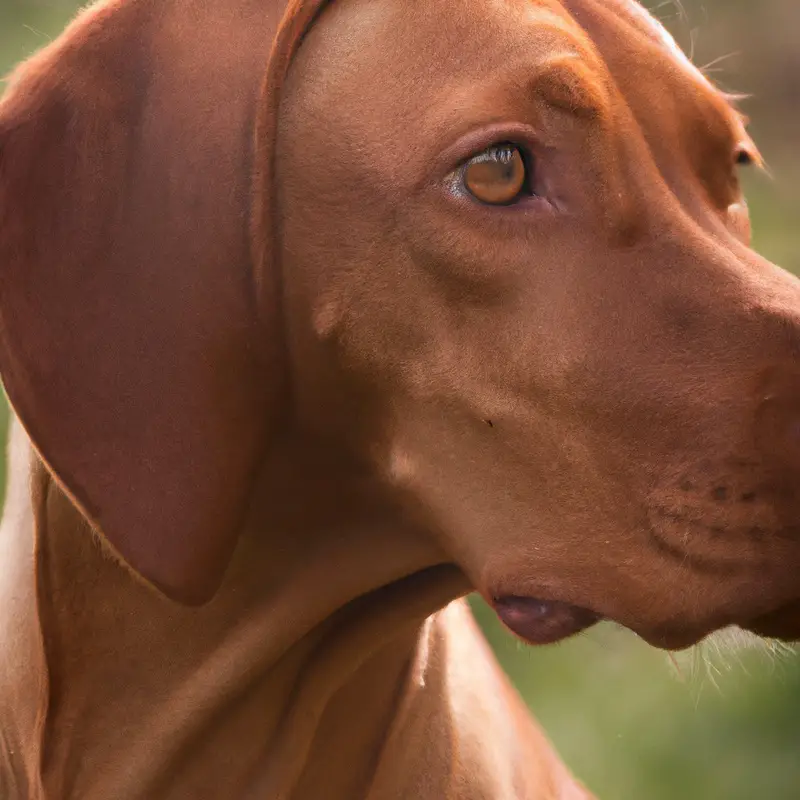
Clean and strong teeth and gums
Clean and strong teeth and gums are important signs of a healthy Vizsla. To keep your Vizsla’s teeth and gums in good condition:
- Brush their teeth regularly with a dog-friendly toothbrush and toothpaste.
- Provide chew toys and dental treats to help remove plaque.
- Schedule regular dental check-ups with a veterinarian to catch any issues early.
- Avoid feeding your Vizsla hard, crunchy, or sticky treats that could damage their teeth.
Remember to consult with your vet for personalized advice on maintaining your Vizsla’s dental health.
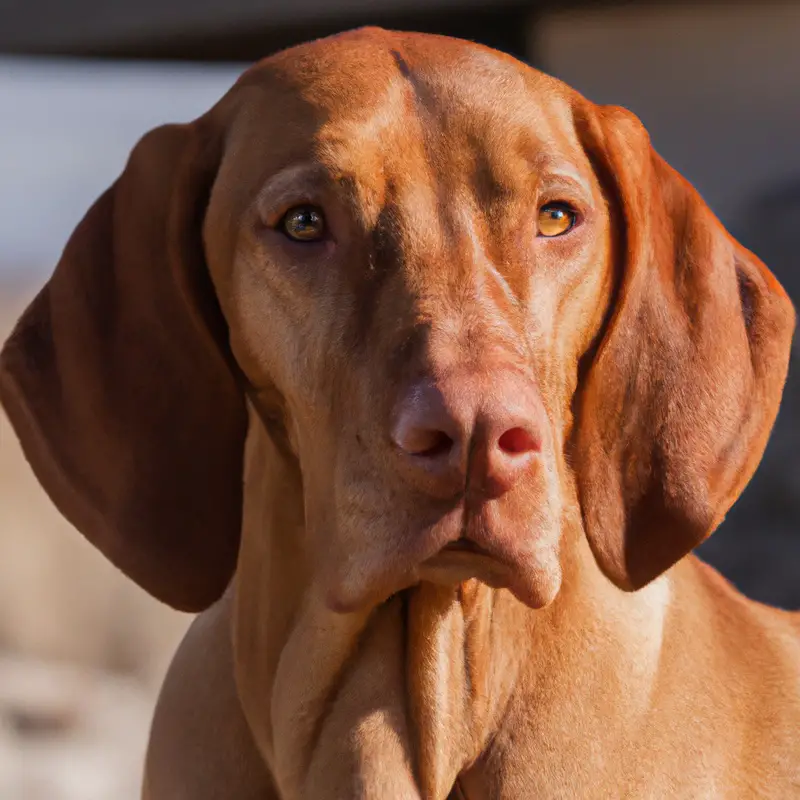
Energetic and agile body
An energetic and agile body is one of the signs of a healthy Vizsla. Their lively nature and athletic build allow them to move with grace and agility.
You can notice their energy in their lively gait and the way they carry themselves.
Vizslas are known for their stamina and ability to keep up with various physical activities, making them a great choice for active individuals or families. Their agile bodies enable them to navigate obstacles with ease, showcasing their athleticism.
Behavioral signs of a healthy Vizsla
Happy and playful demeanor
A happy and playful demeanor is a clear sign of a healthy Vizsla. When your Vizsla is happy and playful, it means they are in good spirits and enjoying life.
They may wag their tail, have a bouncy gait, and exhibit a playful nature.
When they are content and lively, it shows that they are well-adjusted both physically and emotionally. It’s important to pay attention to their behavior and ensure they are having fun and engaging in regular playtime.
Alert and responsive
One of the signs that your Vizsla is healthy is if they are alert and responsive. This means that they are attentive and quick to react to their surroundings.
A healthy Vizsla will have a keen sense of awareness and will show interest in their environment.
They will be responsive to their owner’s commands and will demonstrate good listening skills. Keep an eye out for these behavioral signs to ensure your Vizsla is in good health.
Well-socialized and friendly with people and other animals
A healthy Vizsla is well-socialized and friendly with both people and animals.
They enjoy being around others and have a naturally sociable nature.
A well-socialized Vizsla will exhibit behaviors such as:
- Eagerness to approach and interact with people and animals.
- Comfortable and relaxed body posture in social situations.
- Adaptability to different environments and ability to handle new experiences without fear or aggression.
- Playfulness and willingness to engage in social activities.
It’s important to provide early socialization and positive experiences to ensure your Vizsla grows up to be a friendly and well-adjusted companion.
High levels of activity and exercise tolerance
A healthy Vizsla typically exhibits high levels of activity and exercise tolerance.
They have an abundance of energy and love to be active.
Whether it’s running, hiking, or participating in agility training, Vizslas thrive on physical activity.
They require plenty of daily exercise to keep them mentally and physically stimulated.
In fact, regular exercise is crucial for their overall well-being and helps prevent behavioral issues that may arise from pent-up energy.
A healthy Vizsla is always up for a good workout and will happily join you in any active endeavor.
Common health issues to watch out for in Vizslas
Hip dysplasia
Hip dysplasia is a common health issue in Vizslas.
It is a condition where the hip joint doesn’t develop properly, causing pain and discomfort.
Signs of hip dysplasia include limping, difficulty getting up, and a bunny hopping gait.
Regular exercise, maintaining a healthy weight, and providing joint supplements can help manage hip dysplasia.
Regular vet check-ups are important for early detection and treatment.
Eye problems
Eye problems can occur in Vizslas, so it’s important to be aware of the signs. Look out for redness, discharge, cloudiness, or frequent blinking.
These could indicate an infection, injury, or even a more serious condition like glaucoma.
Regular check-ups with a vet and maintaining good hygiene can help prevent eye problems. If you notice any abnormalities, don’t hesitate to seek professional advice.
Allergies
Allergies can be quite common in Vizslas.
They can develop allergies to various substances such as pollen, dust mites, or certain foods.
Some signs of allergies in Vizslas include itching, redness, hair loss, and skin infections.
Other symptoms may include sneezing, coughing, or gastrointestinal issues.
If you notice any unusual symptoms, it’s important to consult with your veterinarian for proper diagnosis and treatment options.
Cancer
Cancer is a concern in Vizslas, just like in any other breed.
Regular vet check-ups and being aware of potential signs are key.
Keep an eye out for unusual lumps or bumps, weight loss, a decrease in appetite, and changes in behavior or energy levels.
If you notice any of these signs, it’s important to consult your vet for further evaluation.
Remember, early detection can greatly improve treatment outcomes.
Epilepsy
Epilepsy is a common health issue that Vizslas can experience. It is characterized by sudden and recurrent seizures.
Signs of epilepsy in Vizslas include convulsions, loss of consciousness, drooling, and muscle twitching.
If your Vizsla shows any of these symptoms, it’s important to consult a veterinarian for a proper diagnosis and treatment plan. Management of epilepsy may involve medications, lifestyle adjustments, and regular veterinary check-ups to monitor seizure activity.
Maintaining the health of a Vizsla
Regular veterinary check-ups and vaccinations
Regular veterinary check-ups and vaccinations are essential for maintaining the health of your Vizsla.
These check-ups allow the veterinarian to assess your dog’s overall health, detect any potential issues or diseases early on, and provide necessary preventive care.
Vaccinations protect your Vizsla from common contagious diseases and can help prevent serious illnesses.
Make sure to schedule regular visits with your veterinarian and stay up to date with your Vizsla’s vaccinations to keep them healthy and happy.
Proper nutrition and feeding schedule
Proper nutrition and a consistent feeding schedule are essential for maintaining the health of your Vizsla.
Here’s what you need to know:
- Choose high-quality dog food specifically formulated for active breeds like the Vizsla.
- Feed your Vizsla according to its age, size, and activity level. Consult your veterinarian for specific recommendations.
- Divide the daily food portion into two or three meals to prevent overeating and aid digestion.
- Provide fresh water at all times, especially during and after exercise.
- Treats can be given occasionally, but avoid overindulging to prevent weight gain.
- Monitor your Vizsla’s weight and adjust the portion sizes if needed.
- Regularly check for any changes in appetite, weight, or stool quality, and consult your vet if any concerns arise.
Remember, a well-balanced diet and a consistent feeding routine are key to keeping your Vizsla happy and healthy.
Regular exercise and mental stimulation
Regular exercise and mental stimulation are essential for the wellbeing of a Vizsla. Physical activity helps to maintain their muscular and cardiovascular health.
Engaging their minds through mental stimulation helps prevent boredom and destructive behavior.
Take your Vizsla on daily walks, allow them to run off-leash in a safe environment, and provide them with interactive toys that challenge their problem-solving abilities. Incorporating training sessions and puzzle games can keep their minds sharp.
Remember to adjust their exercise routine based on age, health, and individual needs.
Grooming practices for a healthy coat
To maintain a healthy coat for your Vizsla, regular grooming is essential.
Here are some grooming practices you can follow:
- Brush their coat at least once a week to remove dirt, dead hair, and prevent matting.
- Use a gentle dog shampoo and conditioner when bathing them and rinse thoroughly to avoid irritation.
- Check their ears regularly and clean them with a vet-approved solution to prevent infections.
- Trim their nails regularly to keep them at a comfortable length for your Vizsla.
- Brush their teeth regularly to prevent dental issues and maintain good oral hygiene.
Remember, a healthy coat not only looks good but also contributes to your Vizsla’s overall well-being.
So, take the time to groom them regularly and keep them looking their best.
Providing a safe and stimulating environment
To provide a safe and stimulating environment for your Vizsla, there are a few key things you can do. First, make sure your home is free of hazards like toxic plants and chemicals.
Additionally, provide plenty of exercise and mental stimulation through daily walks, play sessions, and puzzle toys.
Create a comfortable resting area for your Vizsla, and establish consistent routines to provide a sense of security. Finally, give your Vizsla plenty of social interaction and mental enrichment by exposing them to new people, animals, and environments.
Frequently Asked Questions (FAQs)
What is the average lifespan of a Vizsla?
The average lifespan of a Vizsla is around 10 to 14 years.
Keep in mind that this can vary depending on various factors such as genetics, overall health, diet, exercise, and veterinary care.
Regular check-ups, a balanced diet, and providing them with enough physical and mental stimulation can help maintain their health and potentially increase their lifespan.
It is also important to be aware of any breed-specific health conditions and to address any concerns with your veterinarian.
How often should I take my Vizsla to the vet?
As an expert, I recommend taking your Vizsla to the vet at least once a year for a routine check-up.
However, since Vizslas are prone to certain health issues, it’s a good idea to visit the vet more frequently.
For puppies, it’s important to have several visits to keep up with vaccinations and ensure their growth is on track.
Older dogs may require more frequent visits to monitor their overall health.
Regular vet visits will help ensure your Vizsla stays healthy and any potential issues can be addressed early on.
What is the best diet for a Vizsla?
The best diet for a Vizsla is a balanced and high-quality dog food that meets their specific nutritional needs. Look for a brand that includes real meat as the main ingredient and avoids fillers and artificial additives.
It’s important to provide them with a mix of protein, healthy fats, and carbohydrates to support their energy levels and maintain a healthy weight.
Consult with your veterinarian to determine the right portion sizes and feeding schedule for your Vizsla.
How much exercise does a Vizsla need?
A Vizsla is an energetic breed that requires a good amount of exercise. Ideally, they need at least an hour of vigorous exercise every day to keep them happy and healthy.
This can include activities such as running, long walks, playtime in a secure area, or even dog sports like agility or flyball.
Regular exercise helps to keep their minds and bodies stimulated, preventing boredom and potential behavior problems. So, make sure to set aside enough time each day to give your Vizsla the exercise they need.
Final Verdict
As an expert in Vizsla health, I can confidently say that there are both physical and behavioral signs that indicate a healthy Vizsla.
A shiny coat, clear eyes, good weight and muscle tone, and clean teeth and gums are all physical indicators of a healthy dog.
Additionally, a Vizsla should exhibit a happy and playful demeanor, be alert and responsive, and have a well-socialized and friendly nature.
To maintain the health of a Vizsla, regular veterinary check-ups, proper nutrition, exercise, grooming, and a stimulating environment are crucial.
By paying attention to these signs and practices, you can ensure that your Vizsla lives a long and healthy life.

